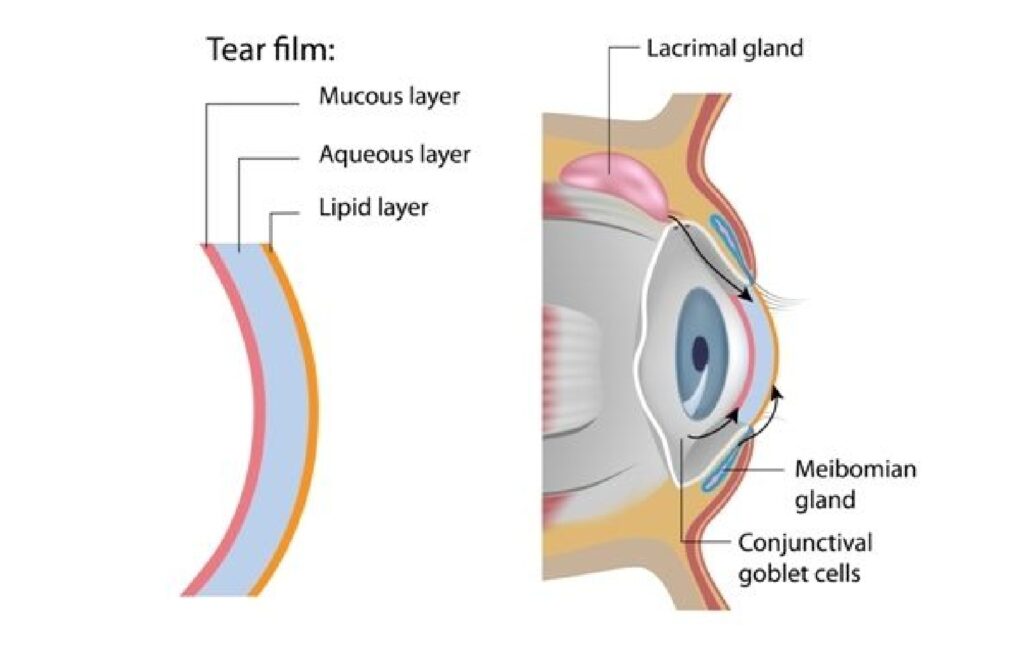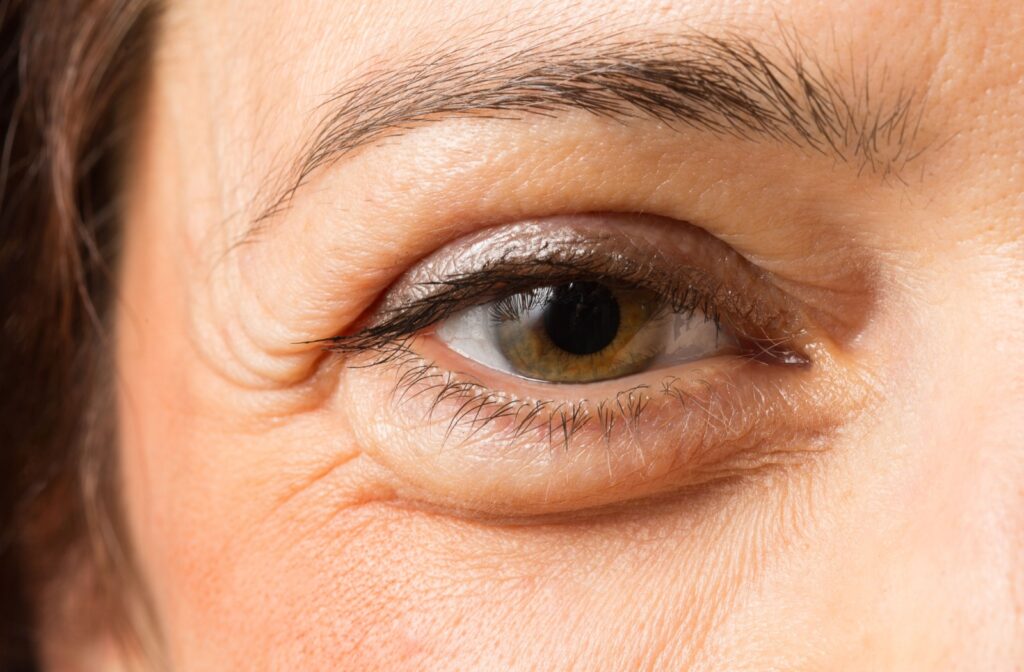The culprit behind that dry, gritty, and uncomfortable feeling in your eyes might be smaller (and closer) than you think. Your meibomian glands, which produce the oily component of your tears, could be blocked, leading to a cascade of pesky symptoms.
On the bright side, addressing blocked or clogged meibomian glands is much easier than you might think. With targeted therapies, such as IRPL therapy and meibomian gland expression, along with at-home management, we can restore normal gland function and promote a healthier, more balanced tear film.
All About Meibomian Glands
Along the edges of your eyelids are the meibomian glands. They produce and secrete the oily layer of your tears (meibum), preventing them from evaporating too quickly from the eye’s surface.
Tears are more than just water. They’re a balance of 3 major components: water, oil, and mucous. A disruption in any of these layers significantly affects the tear film. In this case, without the oily layer, your tears evaporate too quickly, leaving your eyes dry and irritated.
When these glands function properly, you probably don’t give them a second thought. But when your meibomian glands become blocked or inflamed (a condition known as meibomian gland dysfunction or MGD), the effects on your eyes are hard to ignore.
Disruption in these glands can arise from several factors, including:
- Age. As we get older, the oil produced by our meibomian glands naturally becomes thicker and more likely to cause blockages.
- Hormonal changes can affect the quality and quantity of meibum produced. Pregnancy and certain medications that affect hormones can also contribute to MGD.
- Environmental factors such as low humidity, air conditioning, heating systems, and prolonged screen time can exacerbate the problem. When we focus intently on screens, our blinking becomes less frequent and not as complete, which reduces the natural expression of oils from the glands.
- Certain medical conditions, including rosacea, seborrheic dermatitis, and autoimmune disorders, can increase your risk of developing blocked meibomian glands.
The Signs of Blocked Meibomian Glands
Blocked meibomian glands don’t always announce themselves with obvious symptoms. Often, the signs develop gradually, making it easy to dismiss them as temporary irritation or fatigue.
Here are the most common symptoms to watch for:
- Dry, gritty eyes that feel like there’s sand or dust in them. This often worsens throughout the day or after activities that reduce your blink rate, like reading or computer work.
- Burning or stinging sensations can occur, particularly in spaces with air conditioning, heating, or wind. This might be more noticeable when you first wake up or during certain times of the day.
- Watery eyes might seem contradictory when dealing with dryness, but it’s actually a common response. When your eyes don’t have enough quality tears, they produce excess watery tears to compensate, but these tears lack the protective oil layer that’s needed to keep your eyes moist.
- Blurry vision that comes and goes, especially after blinking, can indicate that your tear film isn’t stable. You might notice this particularly when doing detailed work or driving.
- Red, inflamed eyelids or small bumps along the eyelid margin can develop when blocked glands become infected or severely inflamed.

Restoring Meibomian Gland Function: In-Clinic Treatments
Addressing MGD is relatively simple. Treatments focus on restoring proper gland function, which improves tear film health, resulting in tears that hydrate and lubricate your eyes. The key is developing a treatment plan that aligns with you. That’s exactly what our dry eye consultations are for.
After evaluating the health of your tear film, symptoms, and overall eye health, our optometrists might recommend the following in-clinic (and non-invasive) MGD treatments:
Intense Regulated Pulsed Light (IRPL) Therapy
This treatment uses calibrated light pulses to target the inflammation that often accompanies blocked meibomian glands.
During an IRPL session, the device delivers gentle pulses of light to the skin around your eyes. This generates heat, which helps melt thick oil or debris within the glands, while also reducing inflammation that can perpetuate the blockage cycle.
Most patients require a series of sessions, several weeks apart, for ideal results. The beauty of IRPL is that it addresses the immediate symptoms of MGD along with the underlying inflammation that contributes to ongoing problems.
Meibomian Gland Expression
Sometimes, blocked glands need direct intervention, which is where meibomian gland expression comes in. During this procedure, we manually apply gentle pressure to the eyelids.
This softens oils and debris in the glands by warming the eyelids before using an instrument to apply gentle, but targeted pressure, thereby encouraging the blocked materials to flow out.
The idea might sound uncomfortable, but most patients find the procedure quite tolerable, especially considering the relief it provides. Many people notice an immediate improvement in their symptoms, with continued improvement over the following days as the glands resume normal function.
At-Home Treatments
In-clinic treatments are powerful, but work even better when you factor in a good home care regimen. These strategies can help maintain your results and prevent future disruption in the oil glands:
- Heat masks are one of the most effective at-home therapies. Unlike warm washcloths, which cool down quickly, heat masks maintain a consistent temperature long enough to melt the oils in your meibomian glands. Using a heat mask for 10–15 minutes twice daily can help keep the oils flowing naturally.
- Eyelid hygiene is crucial for preventing bacterial buildup that can worsen blockages. Use a gentle cleanser or eyelid wipe to clean your eyelashes and eyelid margins.
- Omega-3 supplements may help improve the quality of the oil that your meibomian glands produce. Fish oil supplements or foods rich in omega-3 fatty acids can support overall eye health.
Take Control of Your Eye Health
Artificial tears hydrate your eyes, but they don’t address the underlying cause of MGD. Targeted therapies, such as IRPL therapy, meibomian gland expression, and warm compress masks help restore normal gland function and improve the health of your tear film.If you suspect blocked meibomian glands are behind persistent dryness and irritation, it’s time for a thorough evaluation. Connect with our InVision Eyecare team to book your dry eye consultation.



